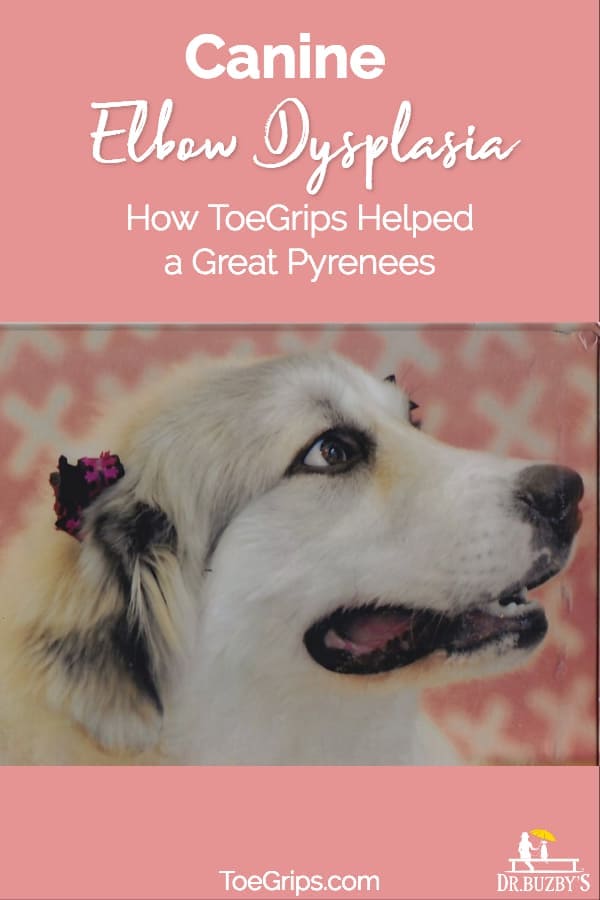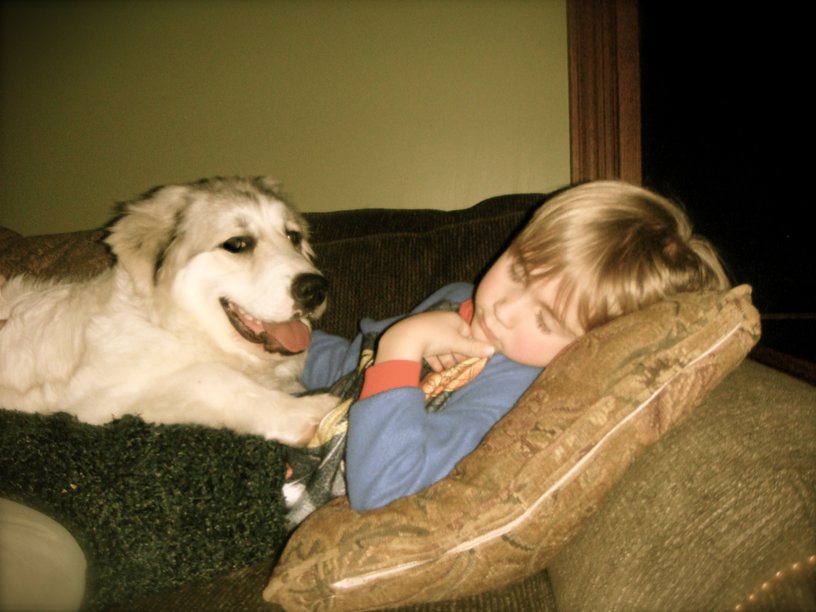
Elbow Dysplasia: Help for a Great Pyrenees
Meet Nanuk, a 5-year-old Great Pyrenees with elbow dysplasia. When Nanuk’s pet parent, Tiffany Hubert, wrote to let us know that ToeGrips® dog nail grips helped her canine companion, we knew we had to share the special story about Nanuk.
ToeGrips® dog nail grips were designed to assist dogs through the hind end, and as far as we know, Nanuk is the first dog to benefit from the grips for a degenerative condition that affects her front limbs
Team ToeGrips is happy Tiffany decided to “think out of the box” to solve a mobility problem for her dog. Her decision has opened new possibilities for us to help other dogs with elbow dysplasia.
Here is what Tiffany wrote…
“I just wanted to thank you so much for your product. I have a 5 year-old Great Pyrenees dog with elbow dysplasia. We recently moved and our new home is mostly tile and hardwood. Additionally, there are two wooden stairs between the living room and the rest of the house.
Nanuk was having a lot of trouble with the stairs and had started pacing back and forth for minutes before walking up them. I was getting concerned because her limping was becoming worse since moving and I could see her confidence deteriorating. I saw an ad for ToeGrips and even though elbow dysplasia was not listed as one of the reasons for using the product I thought I would give it a try anyhow. It was a great decision.
Nanuk no longer paces. She takes the steps easily and her gait has improved vastly! I could not be happier with the results. It does my heart good to see my girl so much more comfortable and confident.”
~Tiffany
Nanuk’s story
Tiffany and her husband Scott are experienced pet parents, and human parents too. Their full household includes Nanuk, another Great Pyrenees named Ghost, two black cats named Shadow and Stucky, and their sons Tristan and Gavin.
The family learns that their Great Pyrenees has elbow dysplasia
Nanuk joined the Hubert family when she was 4 months-old. Soon after, Tiffany noticed a slight limp in Nanuk’s gait that would come and go. By the time the dog was 18-months-old, her limp was more pronounced and her veterinarian began following her condition. At first, they hoped the problem was due to a growth plate, but by the time Nanuk was three years old an x-ray confirmed that she had elbow dysplasia.

What is Elbow Dysplasia
Elbow dysplasiais the most common cause of front limb lameness in young dogs, especially large breeds. The condition refers to the abnormal development of the elbow joint. A dog’s elbow is formed by three bones:
- the humerus, which supports the upper limb from the shoulder to the elbow
- the ulna, which runs from the elbow to the paw
- the radius, which supports the major weight-bearing along the front of the lower limb.
All three of these bones need to grow and develop normally and at the same rate so they can fit perfectly at the elbow.
When these pieces of the puzzle do not grow normally they “produce loose pieces of bone and/or cartilage within the joint that act as irritants much as a pebble does in your shoe.” The condition is painful and eventually severe arthritis sets into the joint.
Facts about Elbow Dysplasia
The first signs of elbow dysplasia usually present themselves as mild to moderate front limb lameness in young dogs between the ages of four to 10 months. If the problem isn’t diagnosed at this stage, a dog’s limb will get worse and severe arthritis sets in. Here are the breeds most commonly affected:
- Bearded Collie
- Bernese Mountain Dog
- Chow Chow
- German Shepherd
- Golden Retriever
- Labrador Retriever
- Newfoundland
- Rottweiler
- St. Bernard
- Bassett Hound
Surgery for Nanuk’s elbow dysplasia
Once Nanuk was diagnosed with elbow dysplasia, she underwent surgery to remove the bone fragments that were causing her pain. The goal of the surgery was to keep the elbow joint from deteriorating further due to the constant grinding of the bone fragments. At the time, it was confirmed that Nanuk had arthritis in her elbow as well.
Following the surgery, Nanuk received laser treatment, underwater treadmill therapy, at-home physical therapy, and massage therapy. She also began taking supplements for her arthritis.
“Her pain never went away, but it was tolerable,” said Tiffany.
A new home for the family, a new challenge, and a new solution for Nanuk
Nanuk continued with a fairly normal life until the family moved to their new home. The new house has hardwood floors and multi-levels that lead from the kitchen to the living room, where Nanuk spends most of her time. Tiffany and Scott noticed their dog having trouble maneuvering on the slick steps as soon as they moved in. First they thought about sanding down the steps to give them more grip and then they looked into installing carpet on them.
Before they made any of these permanent changes, Tiffany found the ToeGrips® dog nail grips Facebook page while she was on Facebook. She knew the nonslip grips are for mobility problems and although the information on the ToeGrips® dog nail grips website didn’t specifically talk about elbow dysplasia, she decided to order a set to try.
ToeGrips® dog nail grips: A great solution for this Great Pyrenees
Tiffany put the ToeGrips® dog nail grips on all four of Nanuk’s paws, and she saw an immediate change in her dog!
“At first Nanuk would pause at the steps, like she had been doing, but now she doesn’t even think about it. She just climbs up those stairs and she’s only been wearing the ToeGrips for a few weeks. It’s also been a great alternative to using the arthritis medications that were prescribed to manage Nanuk’s mobility and pain.”
Thank you, Tiffany! We love hearing stories like this one!
We’re happy to hear that ToeGrips® dog nail grips helped Nanuk. Each success story validates the ToeGrips mission: educating, inspiring and empowering both dogs and the people who love them to have a better quality of life with ToeGrips® dog nail grips.


This is a beautiful story! Toegrips does it again it so warms my heart what these little bands can do for dogs! Thank you for sharing!